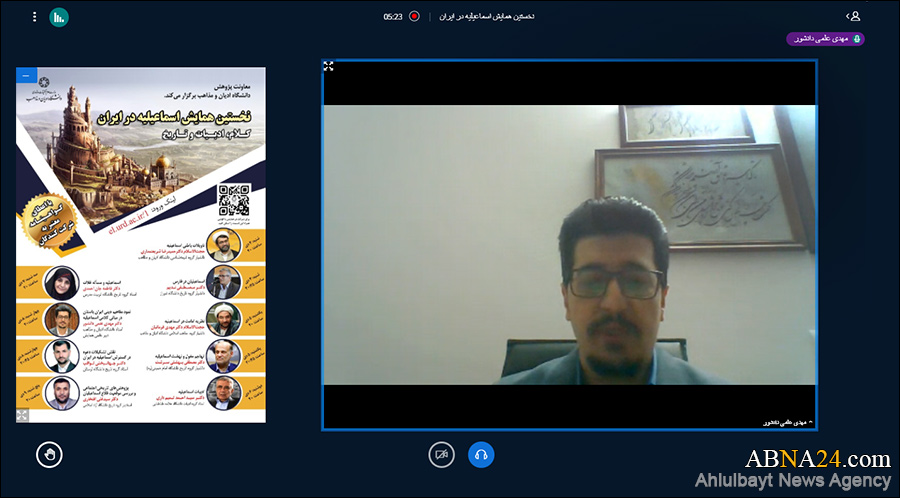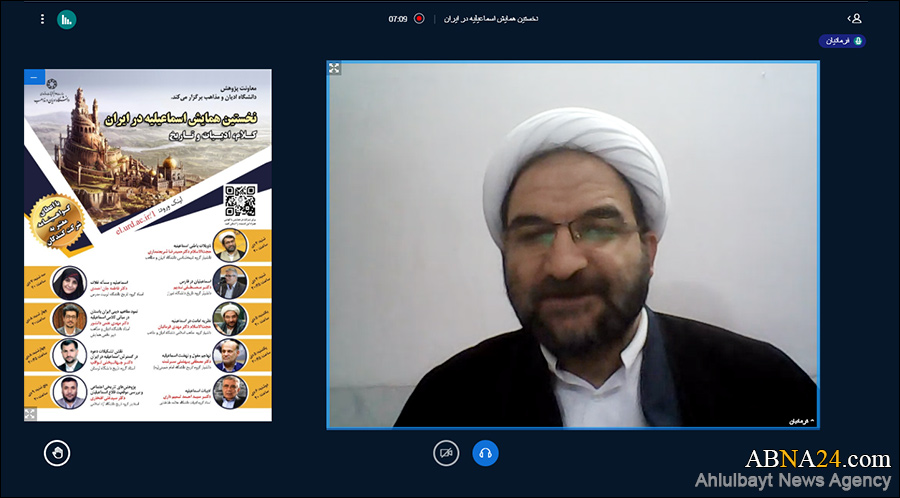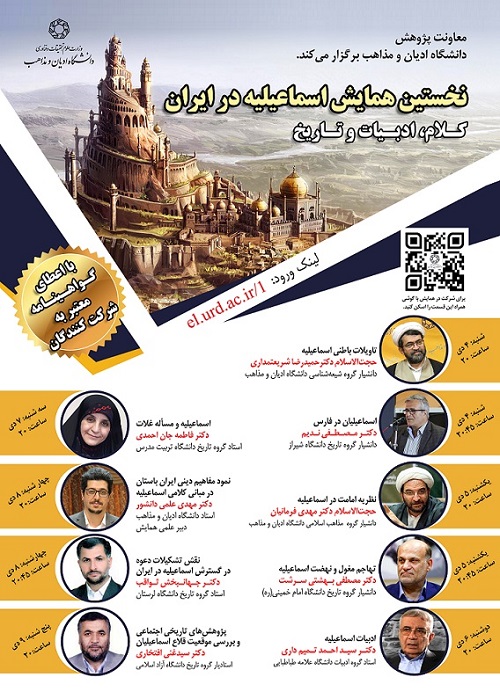The “Imam” has the most important place in the Isma’ilism: Farmanian
The Deputy for Scientific and Cultural Affairs of the AhlulBayt (a.s.) World Assembly said, “According to the Isma’ilism, the Imam has a very important position. They believe that everything is entrusted to the Imam.”
By the Research Department of the University of Religions and Denominations, the first seminar “Isma’ilism in Iran; Theology, Literature and History” started on Saturday, December 25, 2021, in cyberspace and will be held every night until Thursday, December 30.
On the second night of the seminar, which is being held in the form of a webinar, Dr. Hojat al-Islam Farmanian spoke about the “Theory of Imamate in the Isma’ilism” and Dr. Mustafa Nadim about the “Isma’ilism in Fars (Province)”.
It should be said that the secretary of this seminar is Dr. Mahdi Elmi Daneshvar.

Theory of Imamate in Isma’ilism
As the first speaker on the second night of the seminar, Hojat al-Islam Dr. Mahdi Farmanian, Deputy for Scientific and Cultural Affairs of the AhlulBayt (a.s.) World Assembly, spoke on “Theory of Imamate in the Isma’ilism”, and considered this important principle as the most central feature of the Isma’ilis.
As an introduction to his speech, he said, “To understand the theory of Imamate in Isma’ilism, it is necessary to know the “Philosophy of history in Isma’ilism”. Isma’ilism believe in a growing philosophy of history and their view is not linear. They believe that history starts from a mountain in a series of mountains next to another, goes up a slope and reaches the peak, and then goes down, and on the next mountain it goes up and down again, until finally reach the final peak in the last mountain.”
“Twelver Shia and Isma’ili Shia consider history as an uphill that culminates in the emergence of the Imam of End Time (a.s.). In Isma’ili thought, this Imam is called the “Seventh Nateq (orator)”. For them, history will reach its peak when this Nateq emerges and reveals all the unseen. According to them, since the time of the Prophet Adam (a.s.), every Nateq who has come has advanced the world one step,” continued the faculty member of the University of Religions and Denominations.
“But there is disagreement among the Isma’ilis as to who the Seventh Nateq is,” The Deputy of Scientific and Cultural Affairs of the AhlulBayt (a.s.) World Assembly added, “From 260 AH onwards, two views can be seen in the Isma’ilis. The first was the view of Qaramatian, who believed that Muhammad ibn Ismail was the Seventh Nateq. That is, his period was the period of the Seventh Nateq, and the period of the revelation of all unseen things had arrived. Therefore, the Bahraini Nateq no longer believed in Sharia.”
“Another view was that of the Fatimids, who believed that there were three levels in the Imamate of Muhammad ibn Ismail. The first level is the “Physical Level” and it existed during his lifetime and with his death, he hid. The three Imams after him were also hidden until Obaidullah Al-Mahdi became the fourth Imam after Muhammad ibn Ismail. The second level, the “Spiritual Level”, began with the emergence of Obaidullah al-Mahdi. During this period, these Imams showed the inside of the world to some people who were capable. The third level of Muhammad ibn Ismail is the “Level of Qaem Al-Qiama”, who is the Seventh Nateq and will appear in the distance and show the inside of the world to all people of the world. From the perspective of the Fatimids, Muhammad ibn Ismail had three levels: Physical, Spiritual, and Qaem Al-Qiama,” he continued.
“According to Isma’ilism, the Imam has a very important position. They believe that everything is entrusted to the Imam. Some hadiths that contain this type of content are also present in the thoughts of the Ghulat of the Shiites, and people such as Allameh Majlesi have also denied the validity of some of these hadiths. Like the hadith known as “Khotba Al-Bayan”,” Farmanian clarified, regarding the position of the Imamate in the eyes of the Isma’ilism.
“According to us Twelver Shiites, the Imam has three important characteristics; Infallibility, the knowledge of the unseen, and being ordained (based on scriptures). The Isma’ilis also accept the same three characteristics and attributes, but with further elaboration and description,” he continued.
The Deputy of the Scientific and Cultural Affairs of the AhlulBayt (a.s.) World Assembly said that the Isma’ilis consider the Imamate to be of five types:
The first type: “Imam al-Asas” (Basic Imam) means the first Imam after each prophet. For example, Imam Ali (a.s.) who was the basic Imam of the Prophet Muhammad (p.b.u.h);
The second type: “Imam al-Mustaqar” (Established Imam) means the Imam from whose generation the Imamate continues. Like Imam Hussain (a.s.);
The third type: “Imam al-Mostada’a” means the Imam in whom the Imamate was trusted so that the next Imam will have the conditions. Such as Imam Hassan Mojtaba (a.s.), Muhammad Hanafi and Imam Musa ibn Ja'far (a.s.);
The fourth type: “Imam al-Moqim” (Residing Imam) means the last Imam of a period who trains the next prophet and establishes the Imamate in him. Like Hazrat Abu Talib (a.s.) who was the last Imam of the sixth period and established the Imamate in the Prophet Muhammad (p.b.u.h);
The fifth type: “Imam al-Motemm” means the person with whom the Imamate ends.
“In the Ismaili books, either the hadith is narrated from the six Imams who are common with the Twelver Shiites Imams, or scientific material is found from the Ismaili elders such as Abu Ya’qub Sajestani. But not much has been narrated from the Fatimid Imams,” he noted, regarding the jurisprudential and hadith heritage of the Ismaili Imams.

“Imam Musa ibn Ja'far (a.s.) was transferred to Baghdad and imprisoned due to the malice of Muhammad ibn Ismail or his brother Ali ibn Ismail. Therefore, Muhammad ibn Ismail could not stay in Medina after that incident and traveled to Baghdad and died there. But the Isma’ilis deny that he is dead but believe that he has entered a “Hiding Period”,” said the Deputy for the Scientific and Cultural Affairs of the AhlulBayt (a.s.) World Assembly, referring to the history of the Ismaili Imamate.
“After Imam Al-Mustansir, there was a dispute over which of his sons were Imams. Some became supporters of Nizar, and some became supporters of al-Musta’li,” Farmanian stated, referring to some disputes among the Isma’ilis.
“Musta’lawis continued to live in Egypt until Al-Amer bi-Amr Allah died. Then the Musta’lawis of Yemen believed in the Imamate of “Tayyib” and then emigrated to India. In India, they are called “Bohra”, which themselves are divided into three groups: Dawoodi, Alawite and Soleimani,” continued the faculty member of the University of Religions and Denominations.
Referring to some commonalities between the Isma’ilis and the Twelvers, the professor of the seminary and the university said, “For example, the question arises about the issue of Bada’ whether there is Bada’ in the Imamate? According to both the Twelver Shia and the Isma’ili Shiites, there is no Bada’ in the Imamate. Therefore, in the Ismaili works, there is no mention of Bada’.”
Regarding the accusation that “Ismailis do not adhere to religious rules,” he said, “Bohras (Tayyebi Isma’ilis) adhere to Sharia. They pray and fast and go on Hajj and pilgrimage of the holy shrines. But the Nizari Isma’ilis, although do not perform prayer and fasting, they mourn for Imam Hussain (a.s.).”
“The Tayyebi Isma’ilis live mostly in India. While the Nizari Isma’ilis live in different parts of the world and now the “Aga Khan IV” as the 49th Nizari Imam resides in Europe and leads the Nizari from there. The total population of Nizari in the world is estimated at fifteen to twenty million. In Iran, there are a maximum of fifty thousand Isma’ilis, all of whom are Nizari and live in Khorasan (Quhistan), Shahrbabak, Tehran and so on,” said former Deputy for Research Department at the University of Religions and Denominations, regarding the situation and population of the Ismailis.
“Mr. Shah Khalili, the former president of the Ismaili Association of Iran, wrote the book “Seven Pillars of Worship” and asked the Nizaris of Iran to pray and worship. But I do not know why he was fired. Maybe it was because of his book!” Dr. Farmanian said, referring to efforts to persuade Nizaris to follow the Sharia.
He also invited the attendees of the second night of the webinar to read old and new books for further study; Classic books such as “Ta’wil al-Da’im” by Ghazi Nu’man and “Wajh-e-Din” by Nasser Khosrow, a prominent Ismaili scholar, and contemporary books such as “Collection of Isma’ili Articles” by Scholars of the University of Religions and Denominations and “Isma’ili History and Beliefs” by Dr. Farhad Daftari.
At the end of Hojat al-Islam, Dr. Mahdi Farmanian answered a number of questions of the webinar participants.

It should be mentioned that the first seminar “Isma’ilism in Iran; Theology, Literature and History” is being held virtually at the University of Religions and Denominations, with the presence and presentation of seminary and university professors. At the end of the seminar, participants will be awarded valid certificates.
According to the Deputy Office for Research of the University of Religions and Denominations, the lecture program of the professors in this conference is as follows:
1) Saturday, December 25, 2021, 8 pm – Hojat al-Islam Dr. Hamid Reza Shariatmadari (Associate Professor, Department of Shiite Studies, University of Religions and Denominations) – Lecture Topic: Isma’ili esoteric interpretations.
2) Sunday, December 26, 2021, 8 pm – Hojat al-Islam Dr. Mahdi Farmanian (Associate Professor, Department of Islamic Denominations of the University of Religions and Religions) - Lecture topic: Theory of Imamate in the Isma’ilism
3) Sunday, December 26, 2021, 08:45 pm – Dr. Mostafa Nadim (Associate Professor, Department of History, Shiraz University) – Lecture topic: Ismailis in Fars (Province)
4) Monday, December 27, 2021, 8 pm - Dr. Sayed Ahmad Tamimdari (Professor of Literature, Allameh Tabatabai University) – Lecture topic: Isma’ili Literature
5) Tuesday, December 28, 2021, 8 pm - Dr. Fatemeh Jan Ahmadi (Professor of History, Tarbiat Modares University) – Lecture Topic: Ismaili and the Ghulat Issue
6) Wednesday, December 29, 2021, 8 pm - Dr. Mahdi Elmi Daneshvar (researcher of ancient Iranian religions and scientific secretary of the seminar) – Lecture Topic: The manifestation of religious concepts of ancient Iran in the Isma’ili theological foundations
7) Wednesday, December 29, 2021, 08:45 pm – Dr. Jahanbakhsh Sawaqeb (Professor, Department History, Lorestan University) – Lecture topic: The role of Da’awah Organization in the spread of Isma’ilism in Iran
8) Thursday, December 30, 2021, 8 pm – Dr. Sayed Ghani Eftekhari (Assistant Professor, Department of History, Islamic Azad University) – Lecture topic: Social-historical research and the study of the location of Ismaili forts
9) Thursday, December 30, 2021, 08:45 pm – Dr. Mostafa Beheshti Seresht (Associate Professor, Department of History, Imam Khomeini University) – Lecture Topic: Mongol Invasion and the Ismaili Movement
The Deputy for Scientific and Cultural Affairs of the AhlulBayt (a.s.) World Assembly said, “According to the Isma’ilism, the Imam has a very important position. They believe that everything is entrusted to the Imam.”
By the Research Department of the University of Religions and Denominations, the first seminar “Isma’ilism in Iran; Theology, Literature and History” started on Saturday, December 25, 2021, in cyberspace and will be held every night until Thursday, December 30.
On the second night of the seminar, which is being held in the form of a webinar, Dr. Hojat al-Islam Farmanian spoke about the “Theory of Imamate in the Isma’ilism” and Dr. Mustafa Nadim about the “Isma’ilism in Fars (Province)”.
It should be said that the secretary of this seminar is Dr. Mahdi Elmi Daneshvar.

Theory of Imamate in Isma’ilism
As the first speaker on the second night of the seminar, Hojat al-Islam Dr. Mahdi Farmanian, Deputy for Scientific and Cultural Affairs of the AhlulBayt (a.s.) World Assembly, spoke on “Theory of Imamate in the Isma’ilism”, and considered this important principle as the most central feature of the Isma’ilis.
As an introduction to his speech, he said, “To understand the theory of Imamate in Isma’ilism, it is necessary to know the “Philosophy of history in Isma’ilism”. Isma’ilism believe in a growing philosophy of history and their view is not linear. They believe that history starts from a mountain in a series of mountains next to another, goes up a slope and reaches the peak, and then goes down, and on the next mountain it goes up and down again, until finally reach the final peak in the last mountain.”
“Twelver Shia and Isma’ili Shia consider history as an uphill that culminates in the emergence of the Imam of End Time (a.s.). In Isma’ili thought, this Imam is called the “Seventh Nateq (orator)”. For them, history will reach its peak when this Nateq emerges and reveals all the unseen. According to them, since the time of the Prophet Adam (a.s.), every Nateq who has come has advanced the world one step,” continued the faculty member of the University of Religions and Denominations.
“But there is disagreement among the Isma’ilis as to who the Seventh Nateq is,” The Deputy of Scientific and Cultural Affairs of the AhlulBayt (a.s.) World Assembly added, “From 260 AH onwards, two views can be seen in the Isma’ilis. The first was the view of Qaramatian, who believed that Muhammad ibn Ismail was the Seventh Nateq. That is, his period was the period of the Seventh Nateq, and the period of the revelation of all unseen things had arrived. Therefore, the Bahraini Nateq no longer believed in Sharia.”
“Another view was that of the Fatimids, who believed that there were three levels in the Imamate of Muhammad ibn Ismail. The first level is the “Physical Level” and it existed during his lifetime and with his death, he hid. The three Imams after him were also hidden until Obaidullah Al-Mahdi became the fourth Imam after Muhammad ibn Ismail. The second level, the “Spiritual Level”, began with the emergence of Obaidullah al-Mahdi. During this period, these Imams showed the inside of the world to some people who were capable. The third level of Muhammad ibn Ismail is the “Level of Qaem Al-Qiama”, who is the Seventh Nateq and will appear in the distance and show the inside of the world to all people of the world. From the perspective of the Fatimids, Muhammad ibn Ismail had three levels: Physical, Spiritual, and Qaem Al-Qiama,” he continued.
“According to Isma’ilism, the Imam has a very important position. They believe that everything is entrusted to the Imam. Some hadiths that contain this type of content are also present in the thoughts of the Ghulat of the Shiites, and people such as Allameh Majlesi have also denied the validity of some of these hadiths. Like the hadith known as “Khotba Al-Bayan”,” Farmanian clarified, regarding the position of the Imamate in the eyes of the Isma’ilism.
“According to us Twelver Shiites, the Imam has three important characteristics; Infallibility, the knowledge of the unseen, and being ordained (based on scriptures). The Isma’ilis also accept the same three characteristics and attributes, but with further elaboration and description,” he continued.
The Deputy of the Scientific and Cultural Affairs of the AhlulBayt (a.s.) World Assembly said that the Isma’ilis consider the Imamate to be of five types:
The first type: “Imam al-Asas” (Basic Imam) means the first Imam after each prophet. For example, Imam Ali (a.s.) who was the basic Imam of the Prophet Muhammad (p.b.u.h);
The second type: “Imam al-Mustaqar” (Established Imam) means the Imam from whose generation the Imamate continues. Like Imam Hussain (a.s.);
The third type: “Imam al-Mostada’a” means the Imam in whom the Imamate was trusted so that the next Imam will have the conditions. Such as Imam Hassan Mojtaba (a.s.), Muhammad Hanafi and Imam Musa ibn Ja'far (a.s.);
The fourth type: “Imam al-Moqim” (Residing Imam) means the last Imam of a period who trains the next prophet and establishes the Imamate in him. Like Hazrat Abu Talib (a.s.) who was the last Imam of the sixth period and established the Imamate in the Prophet Muhammad (p.b.u.h);
The fifth type: “Imam al-Motemm” means the person with whom the Imamate ends.
“In the Ismaili books, either the hadith is narrated from the six Imams who are common with the Twelver Shiites Imams, or scientific material is found from the Ismaili elders such as Abu Ya’qub Sajestani. But not much has been narrated from the Fatimid Imams,” he noted, regarding the jurisprudential and hadith heritage of the Ismaili Imams.

“Imam Musa ibn Ja'far (a.s.) was transferred to Baghdad and imprisoned due to the malice of Muhammad ibn Ismail or his brother Ali ibn Ismail. Therefore, Muhammad ibn Ismail could not stay in Medina after that incident and traveled to Baghdad and died there. But the Isma’ilis deny that he is dead but believe that he has entered a “Hiding Period”,” said the Deputy for the Scientific and Cultural Affairs of the AhlulBayt (a.s.) World Assembly, referring to the history of the Ismaili Imamate.
“After Imam Al-Mustansir, there was a dispute over which of his sons were Imams. Some became supporters of Nizar, and some became supporters of al-Musta’li,” Farmanian stated, referring to some disputes among the Isma’ilis.
“Musta’lawis continued to live in Egypt until Al-Amer bi-Amr Allah died. Then the Musta’lawis of Yemen believed in the Imamate of “Tayyib” and then emigrated to India. In India, they are called “Bohra”, which themselves are divided into three groups: Dawoodi, Alawite and Soleimani,” continued the faculty member of the University of Religions and Denominations.
Referring to some commonalities between the Isma’ilis and the Twelvers, the professor of the seminary and the university said, “For example, the question arises about the issue of Bada’ whether there is Bada’ in the Imamate? According to both the Twelver Shia and the Isma’ili Shiites, there is no Bada’ in the Imamate. Therefore, in the Ismaili works, there is no mention of Bada’.”
Regarding the accusation that “Ismailis do not adhere to religious rules,” he said, “Bohras (Tayyebi Isma’ilis) adhere to Sharia. They pray and fast and go on Hajj and pilgrimage of the holy shrines. But the Nizari Isma’ilis, although do not perform prayer and fasting, they mourn for Imam Hussain (a.s.).”
“The Tayyebi Isma’ilis live mostly in India. While the Nizari Isma’ilis live in different parts of the world and now the “Aga Khan IV” as the 49th Nizari Imam resides in Europe and leads the Nizari from there. The total population of Nizari in the world is estimated at fifteen to twenty million. In Iran, there are a maximum of fifty thousand Isma’ilis, all of whom are Nizari and live in Khorasan (Quhistan), Shahrbabak, Tehran and so on,” said former Deputy for Research Department at the University of Religions and Denominations, regarding the situation and population of the Ismailis.
“Mr. Shah Khalili, the former president of the Ismaili Association of Iran, wrote the book “Seven Pillars of Worship” and asked the Nizaris of Iran to pray and worship. But I do not know why he was fired. Maybe it was because of his book!” Dr. Farmanian said, referring to efforts to persuade Nizaris to follow the Sharia.
He also invited the attendees of the second night of the webinar to read old and new books for further study; Classic books such as “Ta’wil al-Da’im” by Ghazi Nu’man and “Wajh-e-Din” by Nasser Khosrow, a prominent Ismaili scholar, and contemporary books such as “Collection of Isma’ili Articles” by Scholars of the University of Religions and Denominations and “Isma’ili History and Beliefs” by Dr. Farhad Daftari.
At the end of Hojat al-Islam, Dr. Mahdi Farmanian answered a number of questions of the webinar participants.

It should be mentioned that the first seminar “Isma’ilism in Iran; Theology, Literature and History” is being held virtually at the University of Religions and Denominations, with the presence and presentation of seminary and university professors. At the end of the seminar, participants will be awarded valid certificates.
According to the Deputy Office for Research of the University of Religions and Denominations, the lecture program of the professors in this conference is as follows:
1) Saturday, December 25, 2021, 8 pm – Hojat al-Islam Dr. Hamid Reza Shariatmadari (Associate Professor, Department of Shiite Studies, University of Religions and Denominations) – Lecture Topic: Isma’ili esoteric interpretations.
2) Sunday, December 26, 2021, 8 pm – Hojat al-Islam Dr. Mahdi Farmanian (Associate Professor, Department of Islamic Denominations of the University of Religions and Religions) - Lecture topic: Theory of Imamate in the Isma’ilism
3) Sunday, December 26, 2021, 08:45 pm – Dr. Mostafa Nadim (Associate Professor, Department of History, Shiraz University) – Lecture topic: Ismailis in Fars (Province)
4) Monday, December 27, 2021, 8 pm - Dr. Sayed Ahmad Tamimdari (Professor of Literature, Allameh Tabatabai University) – Lecture topic: Isma’ili Literature
5) Tuesday, December 28, 2021, 8 pm - Dr. Fatemeh Jan Ahmadi (Professor of History, Tarbiat Modares University) – Lecture Topic: Ismaili and the Ghulat Issue
6) Wednesday, December 29, 2021, 8 pm - Dr. Mahdi Elmi Daneshvar (researcher of ancient Iranian religions and scientific secretary of the seminar) – Lecture Topic: The manifestation of religious concepts of ancient Iran in the Isma’ili theological foundations
7) Wednesday, December 29, 2021, 08:45 pm – Dr. Jahanbakhsh Sawaqeb (Professor, Department History, Lorestan University) – Lecture topic: The role of Da’awah Organization in the spread of Isma’ilism in Iran
8) Thursday, December 30, 2021, 8 pm – Dr. Sayed Ghani Eftekhari (Assistant Professor, Department of History, Islamic Azad University) – Lecture topic: Social-historical research and the study of the location of Ismaili forts
9) Thursday, December 30, 2021, 08:45 pm – Dr. Mostafa Beheshti Seresht (Associate Professor, Department of History, Imam Khomeini University) – Lecture Topic: Mongol Invasion and the Ismaili Movement





